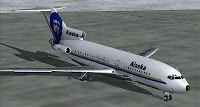The Boeing 737 first flew in 1967 but was envisioned in 1964. It is a short, narrow bodied, twin engined aircraft. It is the most successful commercial aircraft in history, even though more dc3's were built they were mostly produced for the military, not the airlines. More than 6200 aircraft have been built and delivered ranging from the originals up to the next generation version and a few business jets too.
If you are looking for some interesting information about the 737 and the first one produced I suggest looking at
this video. A great information source.
There have been a couple of models before Tinmouse's and I have tried the ffx version. A nice version but it only modeled the aircraft and not the panel and sound. The Tinmouse on the other hand is a complete package with aircraft, panel and sound. And what a package it is!
InstallationInstallation is pretty easy. The
new 1.25 version is much easier than the earlier variants. It contains all you need and is a simple zip file that you unzip into your main fs9 library. There is one
update of the gauges called 1.26 but that is pretty simple to install too, just place the .gau file in the panel folder. There are a number of different versions included, for use with the civa navigation system, with the ISG system
 Panel
PanelThis is what led me to use the plane. The graphics are nice and crisp, the systems are well modeled. If any of you used the old Dreamfleet 737 which I did they remind a bit of those. If you have a pretty good understanding of the workings of the 737 the adaptation to Tinmouse's version is pretty easy. The only big difference is the Sperry autopilot system which can be a bit of a pain at first. I couldn't get the heading hold to engage but didn't switch it to the correct position.
There is a function called CWS which stands for Control Wheel Steering system and is a automatic fight system where the aircraft will hold it's bank and pitch angles. This greatly reduces the workload for the crew and this is what is used for the climb. More information can be found in
this video of a flight on a 737-200 in New Zealand.
In this panel/model the autopilot system doesn't have a altitude

hold so all you can do is set a warning for the correct altitude and when you reach that reduce you climb/descent rate and us the altitude hold function on the autopilot. There is also no autothrottle which means you have to set the power setting by hand according ot the charts or to the small engine computer which is on one of the sub panels. A fun way of doing things that differs significantly from the modern fly-by-wire systems with autothrottle.
 Sound
SoundThe sound set is really good. Not having heard a real 737-200 anytime though it is hard for me too judge the feel of it in comparison to the real thing. I like the number of other sounds than the engine sound like the flap sound, the trim sound and such.
Flight dynamicsIt is a pure pleasure to fly either with the CWS engaged or just by hand. I can't find a bad thing to say about it even though some reports in the forums complain about it being instable after disconnecting the autopilot I did not find this however. One of the great things about the dynamics is the taxi. This baby is a ease to taxi around the tarmac compared to some other models.
Visual modelThe visual model is great, the textures are nice, both the ones included in the package and the many repaints you can download.
Fuel and flap settingsThe one thing I do want to mention is that you have to add the fuel

through the FS9 menu. Other addons like fspassangers can not modify the amount of fuel which led me to a few occasions of fuel starvation because I though I hade added the fuel through fspassengers and I hadn't. The flaps also have to be modified using the flap lever on the panel and can't be altered with assigned keys. At first this is really annoying but you soon get the hang of it.
I should mention one other thing and that is that the model is very accurate, I flew into Seattle and forgot to retract the flaps before I shut the aircraft down and ended up having to restart one engine to get the flaps retracted.
Overall this is a great freeware package with a large number of users and the authors do a great job keeping it up-to-date. It is a bit of a hassle at first but once you get the hang of it it is definitely worth the effort. This is a given in my hangar!
















